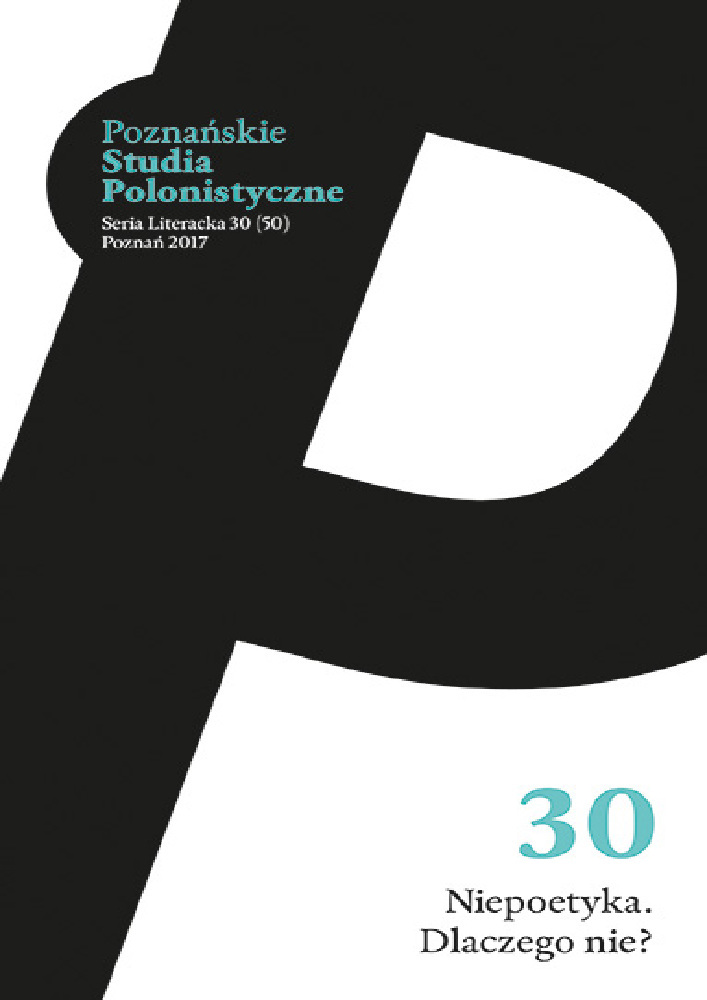Abstrakt
The article deals with phenomena of the Gothic the most often described as a set of often-linked elements rather than a fixed genre. The text presents a variety of cultural incarnations of the convention: from the eighteenth century novel by horror movies to subcultural style of Goths. This essay also examines the basic Gothic concepts, like the uncanny and the abject, which determine the worlds depicted in Gothic narratives, especially characters who remain in close connection with the space formed as a labyrinth. Finally, the article is an attempt to answer the question about the source of the expansion of the aesthetics of the Gothic in the contemporary culture.
Bibliografia
Aguirre Manuel (2002), Geometria strachu. Wykorzystanie przestrzeni w literaturze gotyckiej, przeł. Agnieszka Izdebska, w: Wokół gotycyzmów. Wyobraźnia, groza, okrucieństwo, red. Grzegorz Gazda, Agnieszka Izdebska, Jarosław Płuciennik, Universitas, Kraków, s. 15-32.
Becker Susanne (1999), Gothic Forms of Feminine Fictions, Manchester University Press, Manchester [Wielka Brytania].
Botting Fred (2001), Candygothic, w: The Gothic, ed. Fred Botting, Cambridge University Press, Cambridge [Wielka Brytania], s. 133-151.
Botting Fred (2014), Gothic, Routledge, London [Wielka Brytania].
Botting Fred (2011), Limits of horror. Technology, bodies, Gothic, Manchester University Press, Manchester [Wielka Brytania].
Cohen Jeffrey Jerome (2012), Kultura potwor(n)a: siedem tez, przeł. Maja Brzozowska-Brywczyńska, „Kultura Popularna”, nr 1, s. 170-197.
Dąbrowski Bartosz (2010), Postpamięć i trauma. Myśleć inaczej o literaturze małych ojczyzn (na przykładzie powieści Pawła Huellego i Stefana Chwina), w: Nowe dwudziestolecie (1989-2009). Rozpoznania, hierarchie, perspektywy, red. Hanna Gosk, Dom Wydawniczy Elipsa, Warszawa, s. 219-223.
Douglas Mary (2007), Czystość i zmaza, przeł. Marta Bucholc, Państwowy Instytut Wydawniczy, Warszawa.
Freud Sigmund (1997), Niesamowite, w: tegoż, Pisma psychologiczne, przeł. Robert Reszke, Wydawnictwo KR, Warszawa, t. III, s. 233-262.
Gelder Ken (2014), The postcolonial Gothic, w: The Cambridge Companion to the Modern Gothic, ed. Jerrold E. Hogle, Cambridge University Press, Cambridge [Wielka Brytania], s. 191-207.
Groom Nick (2012), The Gothic. A Very Short Introduction, Oxford University Press, Oxford [Wielka Brytania].
Hogle Jerrold E. (2014), Introduction: modernity and the proliferation of the Gothic, w: The Cambridge Companion to the Modern Gothic, ed. Jerrold E. Hogle, Cambridge University Press, Cambridge [Wielka Brytania], s. 3-19.
Hurley Kelly (2007), Abject and Grotesque, w: The Routledge Companion to Gothic, ed. Catherine Spooner and Emma McEvoy, Routledge, London[Wielka Brytania], s. 137-146.
Izdebska Agnieszka (2000), Literackie i filmowe konteksty gatunkowe postgotycyzmu, w: Genologia dzisiaj, red. Ireneusz Opacki i Włodzimierz Bolecki, Instytut Badań Literackich, Warszawa 2000, s. 130-137.
Izdebska Agnieszka (2002), Gotyckie labirynty, w: Wokół gotycyzmów. Wyobraźnia, groza, okrucieństwo, red. Grzegorz Gazda, Agnieszka Izdebska, Jarosław Płuciennik, Universitas, Kraków, s. 33-41.
Izdebska Agnieszka (2014), Opowieści o „miastach odzyskanych” – proza Stefana Chwina, Pawła Huelle, Joanny Bator i Ingi Iwasiów, „Białostockie Studia Literaturoznawcze”, nr 5, DOI: 10.15290.
Janion Maria (2008), Wampir: biografia symboliczna, słowo/obraz/terytoria, Gdańsk.
Kristeva Julia (2007), Potęga obrzydzenia. Esej o wstręcie, przeł. Maciej Falski, Wydawnictwo Uniwersytetu Jagiellońskiego, Kraków.
Kokot Joanna (2013), W świetle gazowych latarni. O angielskiej prozie „gotyckiej” przełomu XIX i XX wieku, Wydawnictwo Adam Marszałek, Toruń.
Lem Stanisław (1989), Fantastyka i futurologia, Wydawnictwo Literackie, Kraków, t. I.
Marcela Mikołaj, (2015), Monstruarium nowoczesne, Wydawnictwo Uniwersytetu Śląskiego, Katowice 2015.
Punter David (1996), The Literature of Terror. A History of Gothic Fictions from 1765 to the Present Day, t. 1 The Gothic Tradition, t. 2 The Modern Gothic, Longman, London [Wielka Brytania].
Russ Joanna (1995), Somebody’s Trying to Kill Me and I Think It’s My Husband: The Modern Gothic, w: tejże, To Write Like a Woman. Essays in Feminism and Science-fiction, Indiana University Press, Bloomington & Indianapolis [Stany Zjednoczone], s. 94-119.
Rybicka Elżbieta (2011), Pamięć i miasto. Palimpsest vs. pole walki, „Teksty Drugie”, nr 5, s. 201-211, DOI 10.14756/pt.
Spooner Catherine (2006), Contemporary Gothic, Reaktion Books, London [Wielka Brytania].
Spooner Catherine, McEvoy Emma (2007), Introduction, w: The Routledge Companion to Gothic, ed. Catherine Spooner and Eemma McEvoy, Routledge, London [Wielka Brytania], s. 1-3.
Spooner Catherine, (2004), Fashioning Gothic Bodies, Manchester University Press, Manchester [Wielka Brytania].
Turney Jon (2001), Ślady Frankensteina. Nauka, genetyka i kultura masowa, przeł. Marta Wiśniewska, PIW, Warszawa.
Williams Anne (1995), Art of Darkness. A Poetics of Gothic, The University of Chicago Press, Chicago [Stany Zjednoczone].
Licencja
Autorzy
Autorzy tekstów przyjętych do publikacji w czasopiśmie „Poznańskie Studia Polonistyczne. Seria Literacka” są zobowiązani do wypełnienia, podpisania i odesłania na adres redakcji umowy o udzielenie nieodpłatnej licencji do utworów, z zobowiązaniem do udzielania sublicencji CC.
Zgodnie z umową, autorzy tekstów opublikowanych w czasopiśmie „Poznańskie Studia Polonistyczne. Seria Literacka” udzielają Uniwersytetowi im. Adama Mickiewicza w Poznaniu niewyłącznej i nieodpłatnej licencji oraz zezwalają na użycie sublicencji Creative Commons Attribution-NoDerivatives 4.0 International (CC BY-ND 4.0).
Autorzy zachowują prawa do dalszego, swobodnego rozporządzania utworem.
Użytkownicy
Zainteresowani użytkownicy internetu uprawnieni są do korzystania z utworów opublikowanych od 2016 roku w „Poznańskich Studiach Polonistycznych. Serii Literackiej” pod następującymi warunkami:
- uznanie autorstwa – obowiązek podania wraz z rozpowszechnionym utworem, informacji, o autorstwie, tytule, źródle (odnośniki do oryginalnego utworu, DOI) oraz samej licencji;
- bez tworzenia utworów zależnych – utwór musi być zachowany w oryginalnej postaci, nie można bez zgody twórcy rozpowszechniać np. tłumaczeń, opracowań.
Do wszystkich tekstów opublikowanych przed 2016 r. prawa autorskie są zastrzeżone.
Inne
Uniwersytet im. Adama Mickiewicza w Poznaniu zachowuje prawo do czasopisma jako całości (układ, forma graficzna, tytuł, projekt okładki, logo itp.).
